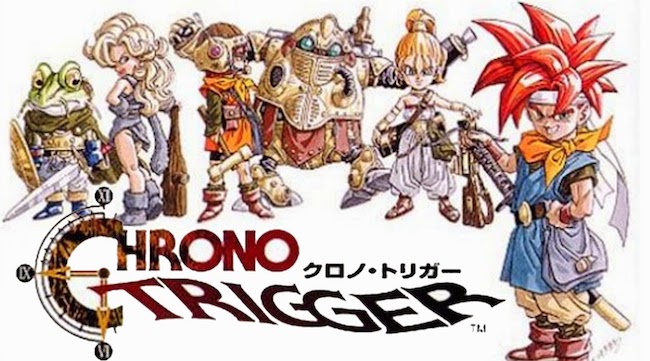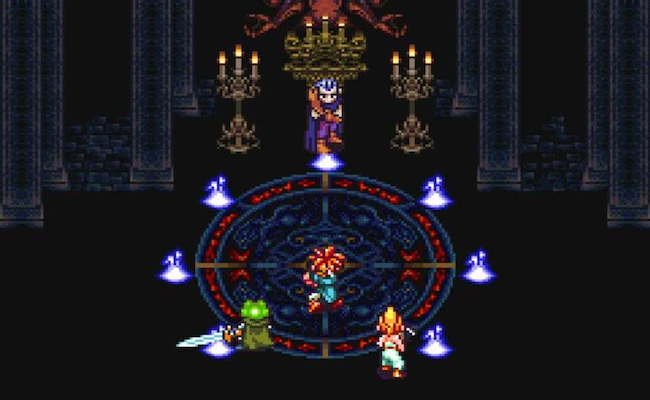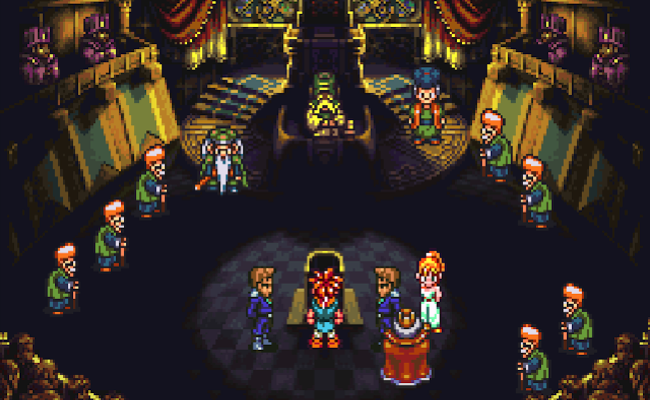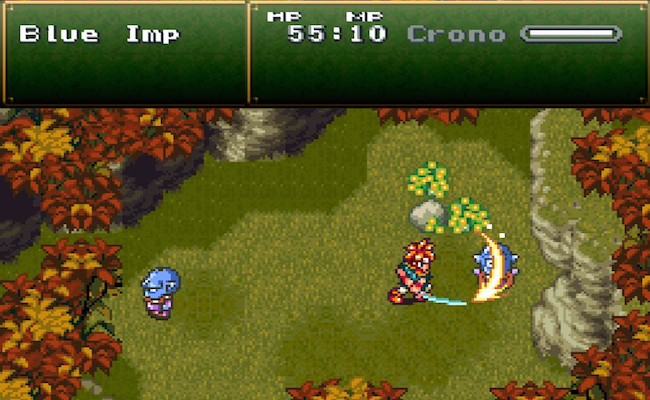
Editor Note: If you’re not familiar with the term “pile of shame”: basically, it’s all the games you’ve purchased over the years, but never gotten around to playing. We’re now working our way back to retrospectively review some of ours!
Chrono Trigger has been on my pile of shame pretty much since I started playing video games. To most people I know, it would come as a surprise that I, out of all people, haven’t yet played this title – especially as the game was presented to me as something someone who had a healthy dose of dinosaurs and robots present whilst growing up would enjoy. For the longest time, I have seen Chrono Trigger referred to in articles as an excellent title, and throughout the years I have also seen so many screenshots of the game that I could instantly recognize the gameplay if ever I saw it. In hindsight, it was clear more than ever that this is exactly the sort of game I could really sink my teeth into, so, after all these years, I finally set myself a couple days aside to dive into the Chrono Trigger universe.
Coming into this game so many years after its initial release, I was already expecting great things due to its acclaim and the dream-team of developers behind the title. However, in addition to the fantastic universe that the game was set in, the games mechanics, art style and execution were all well beyond what I had expected. Chrono Trigger is very much deserving of its status, which, despite its age, still offers a very fresh take on the RPG genre in my opinion.

The premise of Chrono Trigger follows a formula you’d expect for any typical RPG. Basically, as the hero, you set out to defeat a giant monster that will destroy the world, and while you’re at it: save a queen, grab a legendary sword, and defeat some evil army commanders. However, throw in some time-travel, and the story takes on a distinctive form.
When reflecting on other uses of time travel in games, I tend to think back to harrowing experiences such as Blazblue: Calamity Trigger; where a note pad, diagrams and flow charts were needed to figure out exactly what events were happening when. Chrono Trigger, however, made it a pleasure to follow the story of the hero, which most call Crono, travelling through the past, present and future; creating a posse of endearing characters, of which some include a prehistoric cat-woman, a knighted frog, and even a submissive robot. Naturally, with his dream-team in tow, Cronos must then set out to defeat the ultimate evil, which was an engaging, and at times, emotional narrative experience.

One core element which sets up the intuitive, time-travel driven narrative is the interaction players have with the typical RPG NPCs. Whenever ending up in a new location, a conversation with the villagers would almost always provide the context needed to understand when and where you were. It was my observation that every NPC was placed for a reason, to provide insight into significant people, places and events; in and around that area. The games dialogue was also written to ensure the player was well aware of the various events taking place, so rarely did I feel lost on my grand journey through space and time. I always felt as if I was fully immersed in the rich story of the world, which was great.
Furthermore, the player’s interaction with the world is developed to a point where it almost feels as if every action taken by the player has a direct correlation with the story. As such, the player’s influence can also be attributed to the 13 different endings that one can experience in Chrono Trigger. Once the player reaches a certain point in the game, they can choose whenever they wish to defeat the final boss, which, upon doing so, will trigger a different ending to depending on the previous actions and how far into the game the player was. As well as this, the player also has the option to do multiple side quests for the various characters they meet. These side quests set up an organic premise to explore the rich universe in Chrono Trigger, with the adventures touching on various themes ranging from racism and segregation, all the way to the relationships between humans and Artificial Intelligence in the future. That being said, the way all the different story’s interact with each other are almost seamless despite how distinctive each setting is.

One thing I was quite satisfied with was the pacing of the game. Chrono Trigger doesn’t give you full context or all the mechanics within the first few tutorial scenes. Rather, you play the game and comparatively and slowly discover more facets as you go. For instance, magic always plays a major role in the game, but during later stages elemental magic is necessary to defeat certain enemies; noted, the player is not introduced to this concept until a good three hours into playing the game. Just when you think you have learned all the main mechanics and have begun questing your way to the conclusion, another major mechanic is thrown into the mix to keep the experience feeling fresh throughout.
Something which convinced me prior to playing that this game was going to be fun were the screenshots I had seen of the boss battles. You can anticipate a variety of daunting creatures that take up a good portion of the screen estate, with many bosses being a challenge to defeat, and I absolutely mean a real challenge – not a “waiting game” that masks itself as being difficult. Bosses are often immune to certain attacks, or if certain parts of the boss aren’t attacked then they would be able to do a devastating counter-attack that could wipe out your entire party.

The bosses take strategy, so the player has to put thought into what combo of attacks to use, when to heal, and which part of the boss to attack – all before the enemy makes their first move. In fact, I haven’t felt this satisfied when defeating a boss in a long while. In most games, a boss battle equates to an enemy which is given a crazy amount of health. However, if a player is patient enough they can just whittle it down. Chrono Trigger, on the other hand, forces the player to strategize, providing great satisfaction in knowing each major win was based on skill as opposed to time.
What’s also interesting is that encounters with regular enemies have their own intuitiveness too. As opposed to other turned based RPGs, when players encounter an enemy in Chrono Trigger, the combat would actually take place in the world as opposed to cutting to a separate combat scene. This meant players could organically encounter enemies while exploring, and in some cases, even provide strategic options such as sneaking to avoid a fight. In my opinion, the game flowed a lot more smoothly encountering enemies in this fashion, giving the player time to wander around and absorb the beautifully presented world they were in, without being ripped out of it by a random enemy encounter.

Generally speaking, the combat in the game is very clever too. Taking a page from the Final Fantasy games that were being developed by Squaresoft around the same time, the combat in Chrono Trigger plays out in a turn-based fashion. However, once the cooldown of an attack is finished, the player, or the enemy, is free to place another attack regardless of whether the opponent has attacked or not. This unique approach created a somewhat intense experience as I discovered I had to string my moves together quickly, before the enemy could commence an attack.
A major component within the combat mechanics that I really enjoyed were the combos. Not only was each character equipped with powers that greatly helped during battle, but Chrono Trigger goes that one step further to allow the player to combine character powers for a much stronger collaborative attack. For example, Marle can enchant Crono’s Blade to allow him to heal the entire party with his cyclone move, or you could instead combine all three magical powers of Crono, Lucca and Marle to deliver an all-out fire, ice and lightning combo. Every playable character has a relationship with the others that allows for unique moves with each combination of characters. It made the game a lot of fun to play as I would often shuffle my party around to see what moves best-fit to my personal play style.

The art is the first thing that caught my attention when I started playing. Chrono Trigger is very pretty, using 16 bit graphics; the artist did an amazing job creating both vibrant and bleak worlds. Often I would find myself wandering around the world soaking in the meticulous details that went into creating a distinctive universe. Chrono Trigger also spans many different settings, from a prehistoric jungle to a magical floating kingdom, to a desolate factory wasteland: each with its own distinctive atmosphere and look, but still connecting organically despite the differences in tone.
Accompanying the attractive art style is an equally impressive soundtrack. The music was always right on key when setting the mood for the various environments in which the player found themselves. The score does a really effective job of immersing the player in the universe, and consistently works to complement those stunning SNES-era visuals.
It didn’t take long to figure out why Chrono Trigger is still held in such high regard. The game kept me engrossed the entire way through, and in my opinion, is every bit deserving of its accolades. From stunning aesthetics to a very fun combat system, Chrono Trigger does extremely well to engross the player in its universe. This game has held up remarkably well despite its age, providing an experience all fans of the RPG genre should play, and then re-play!











